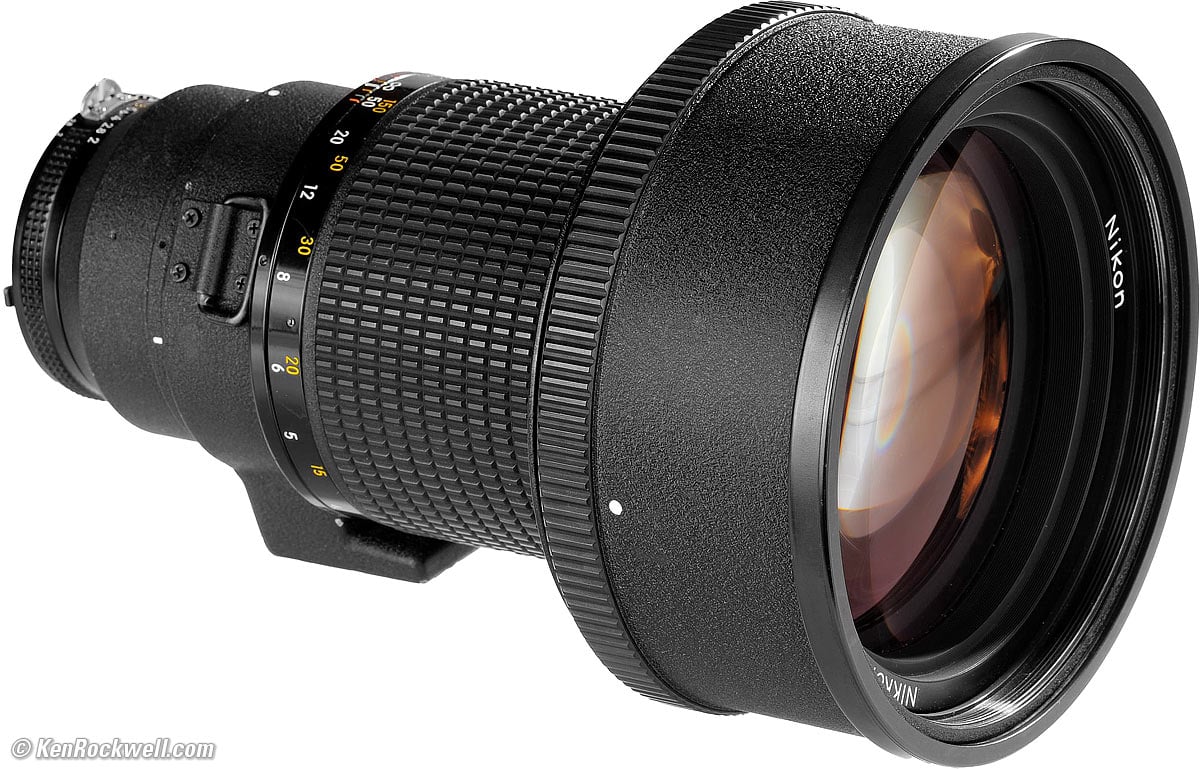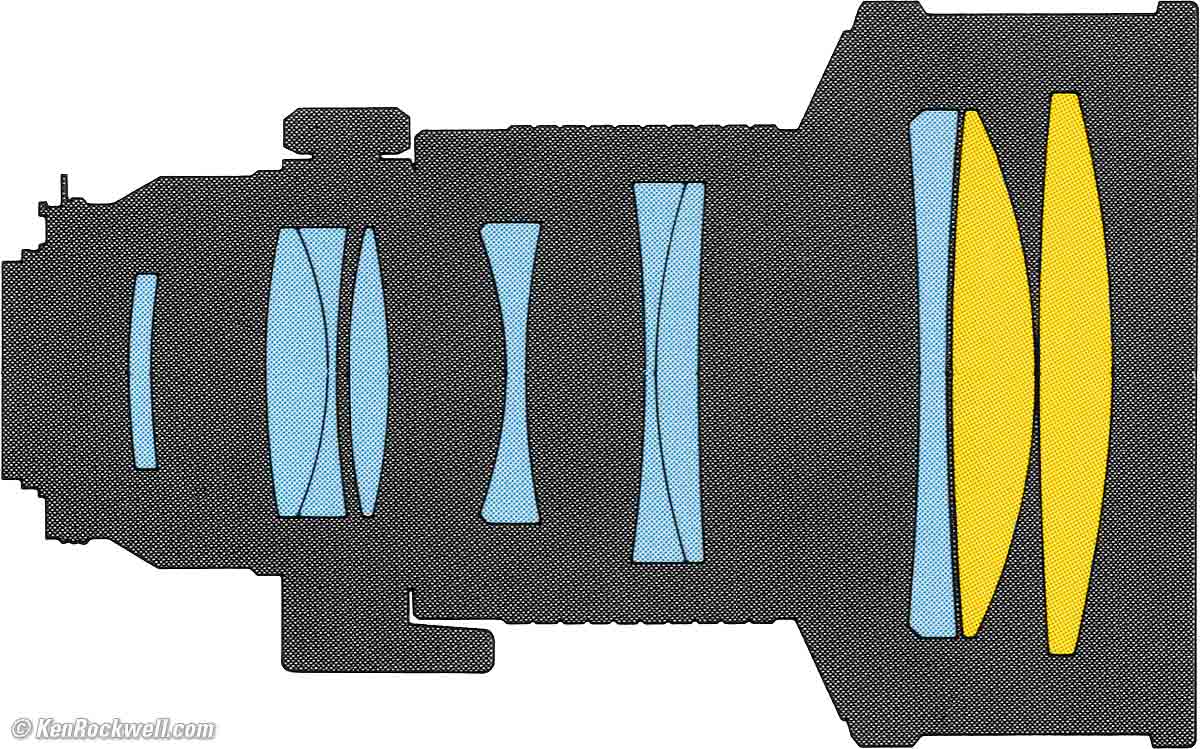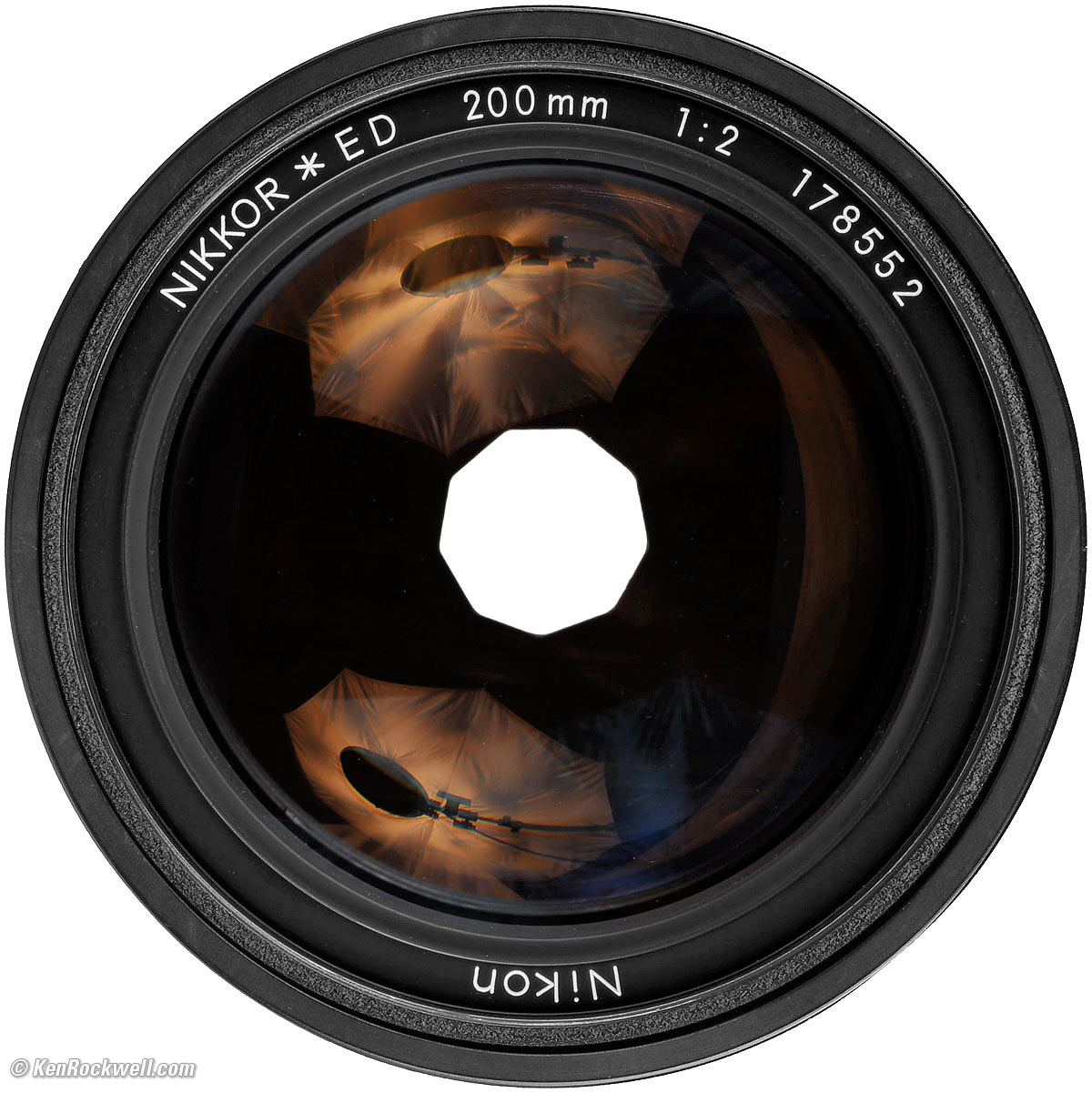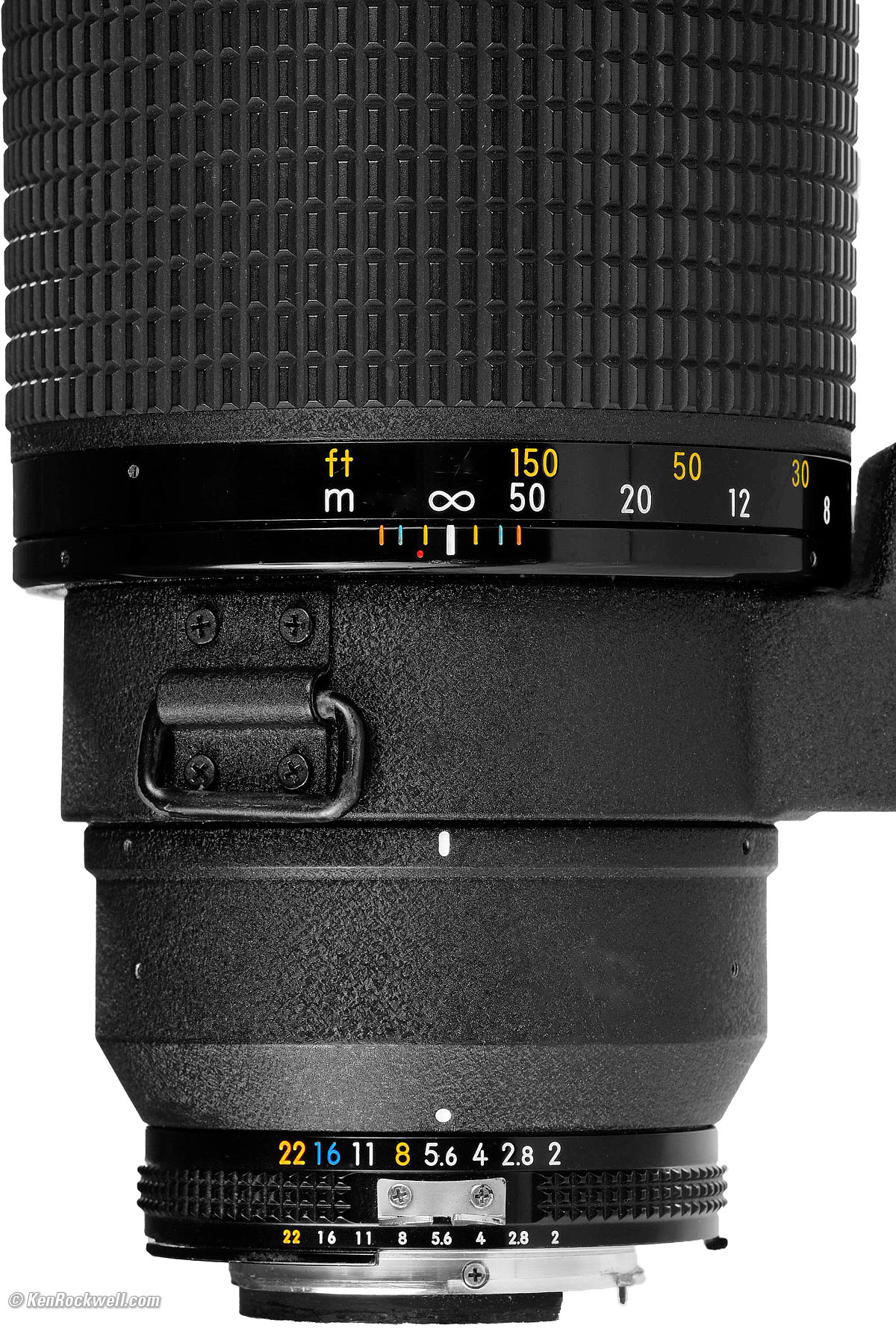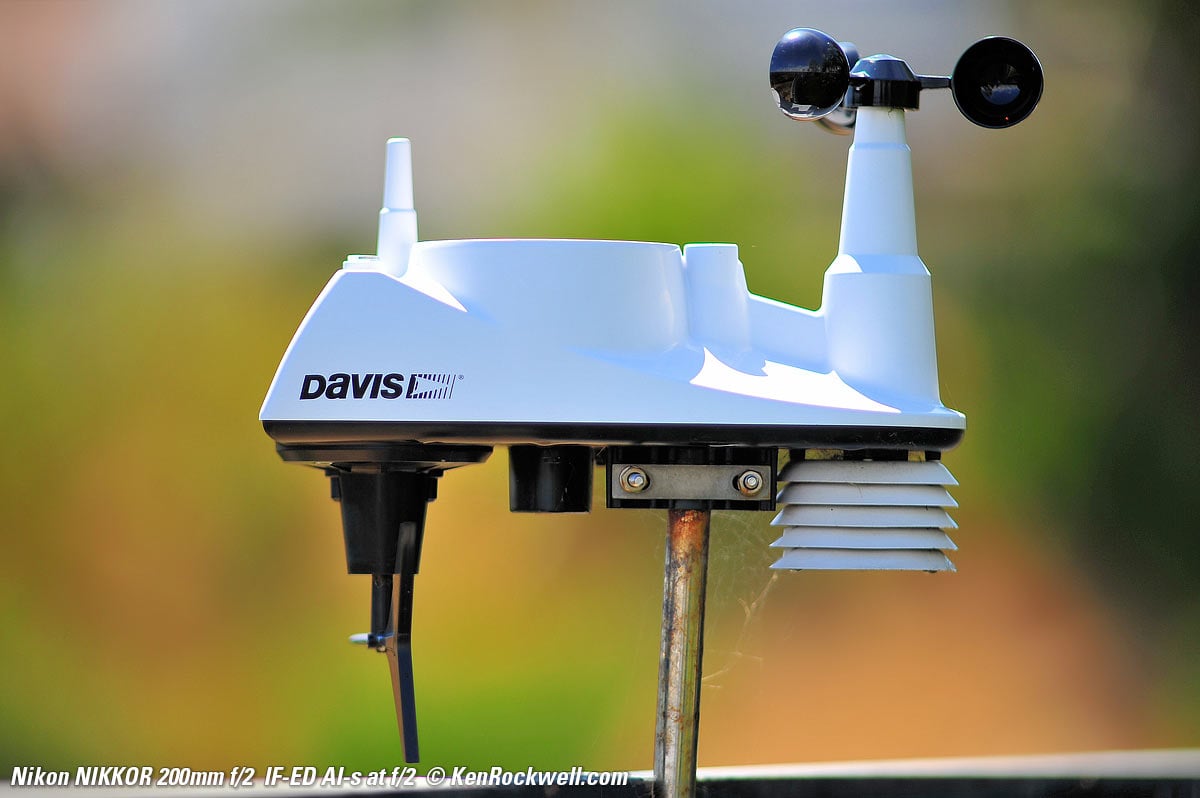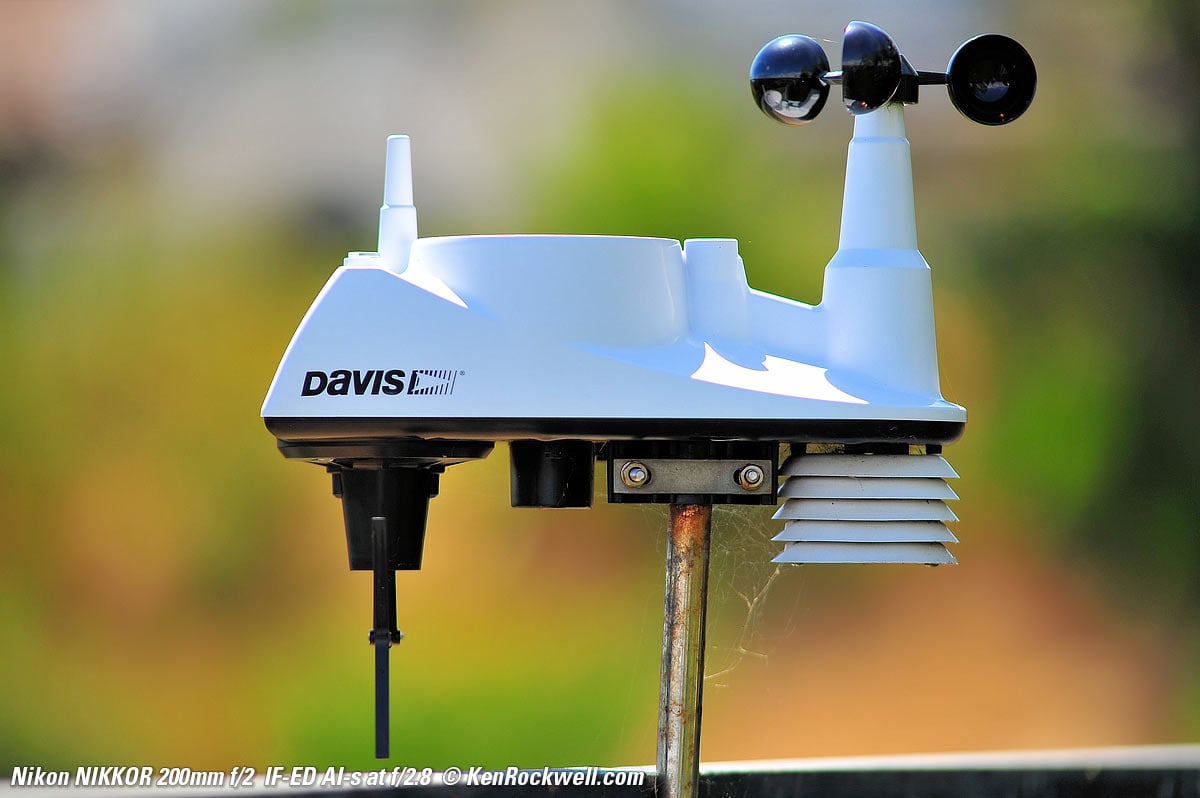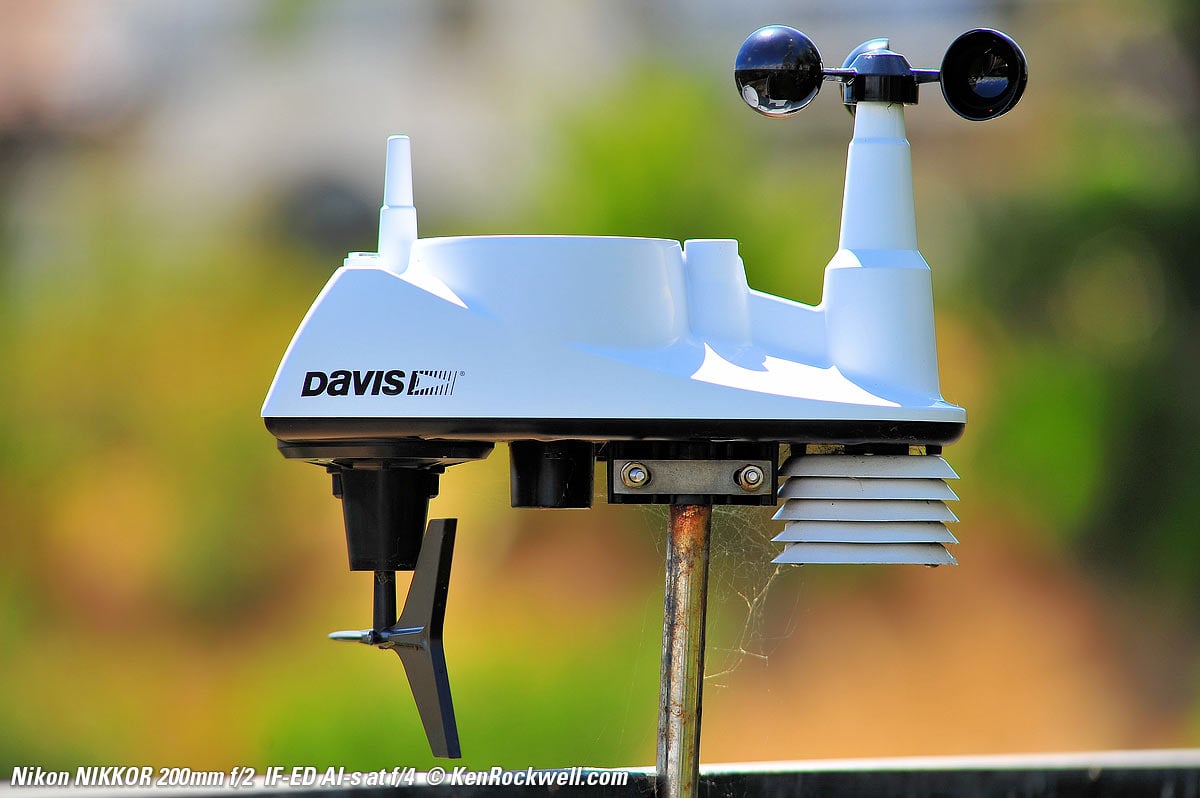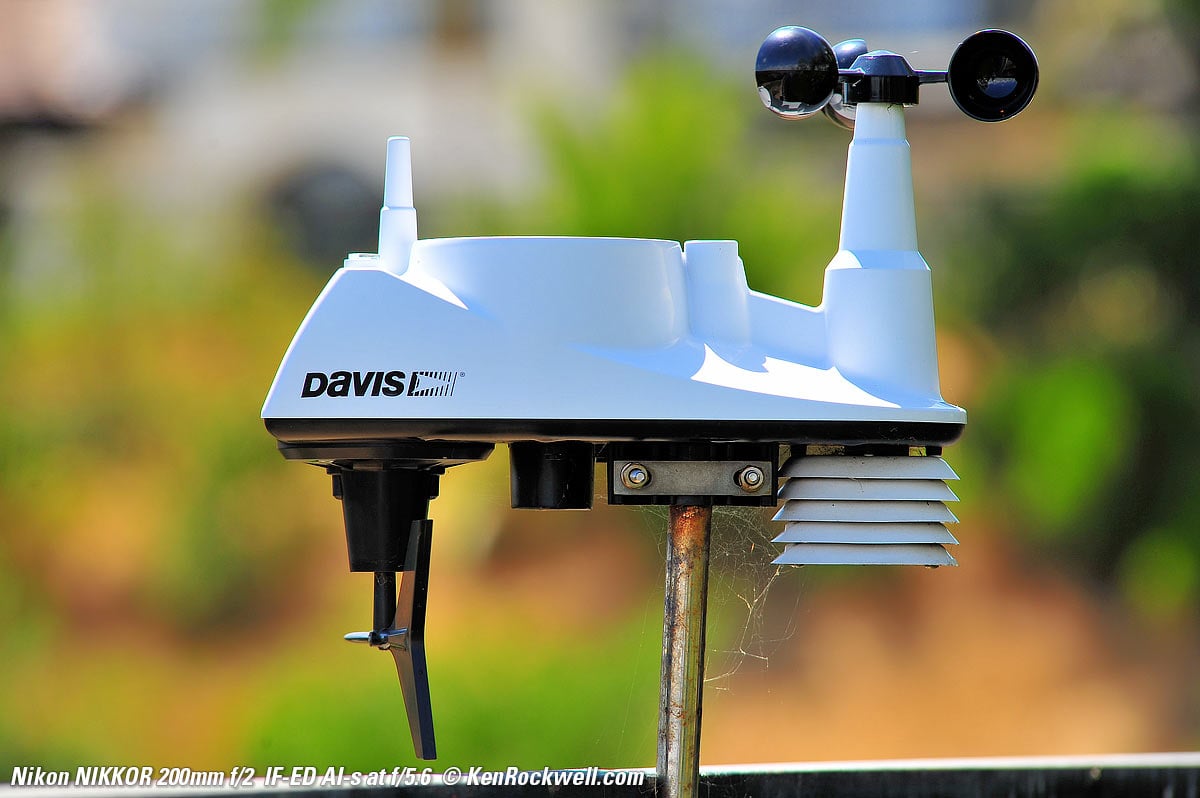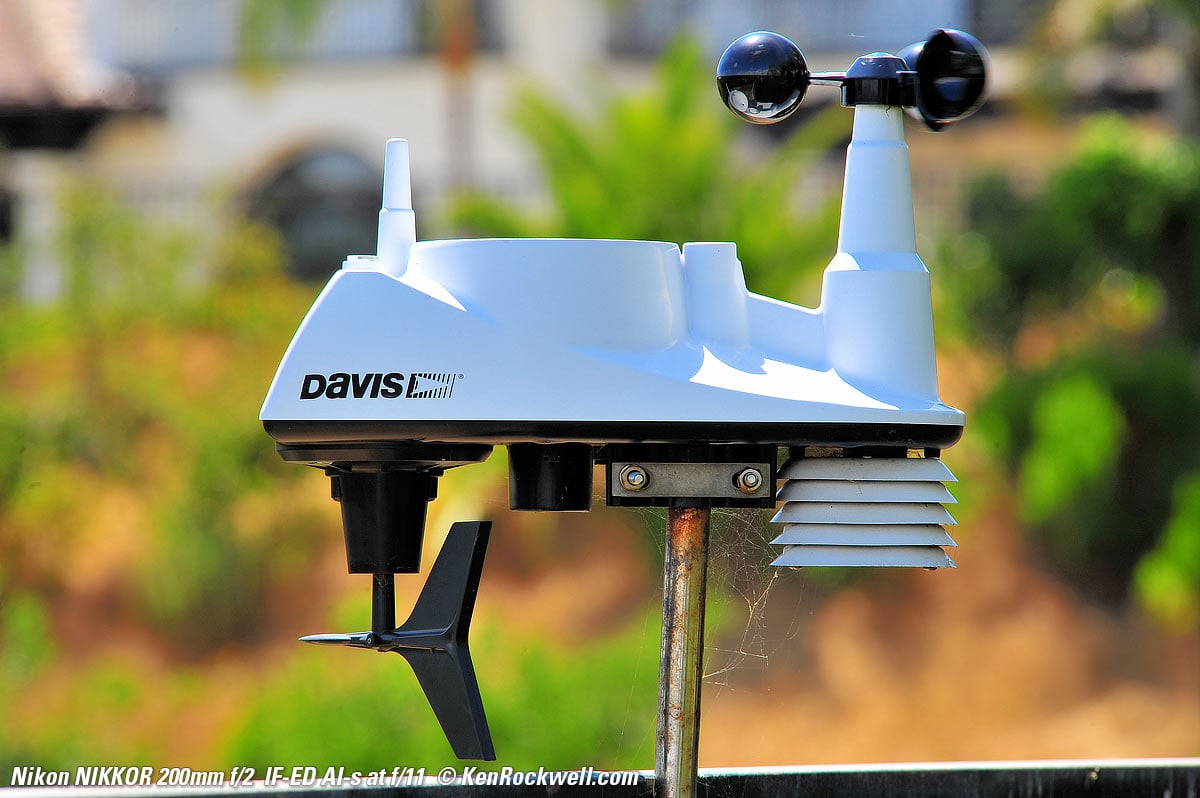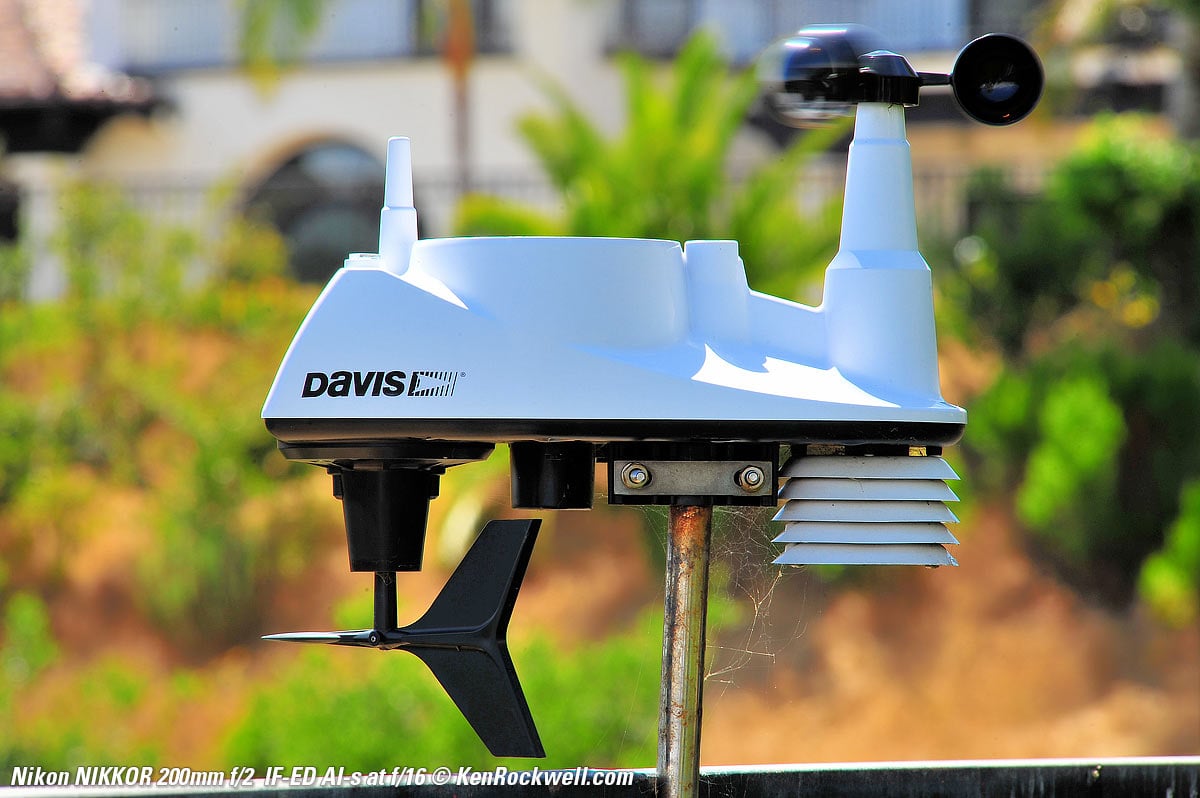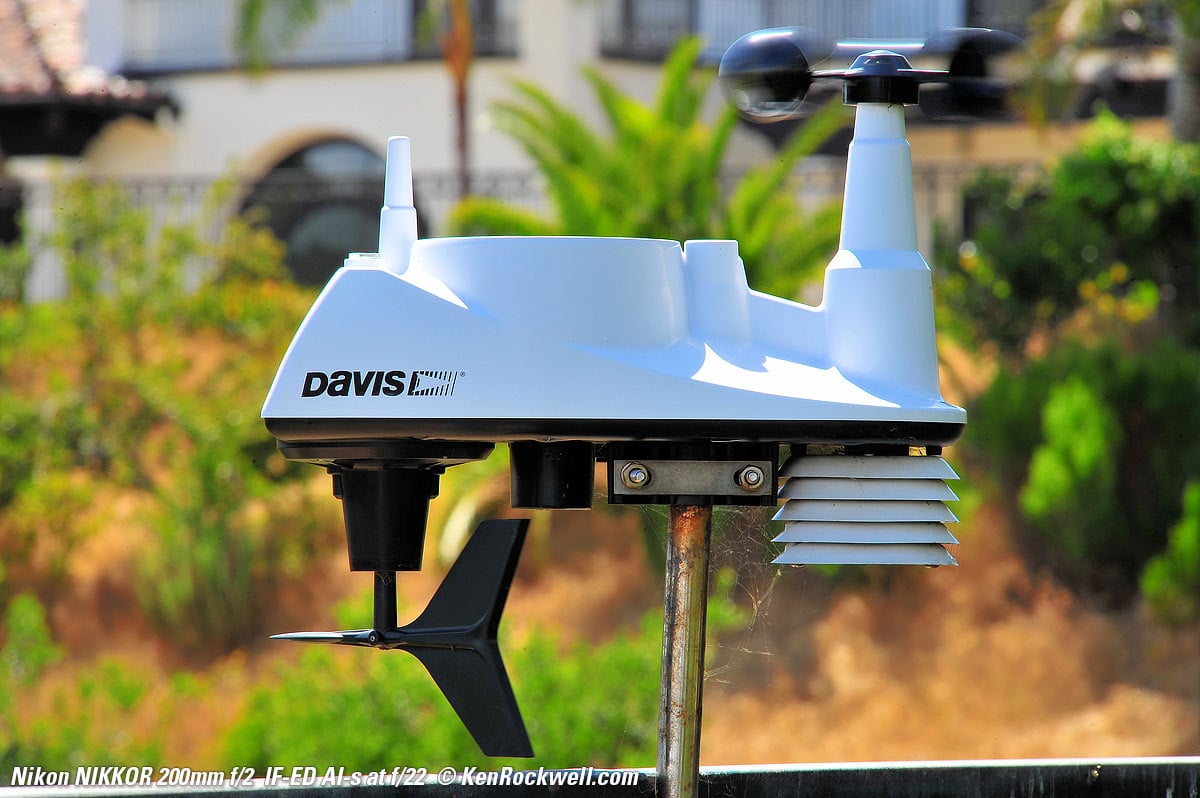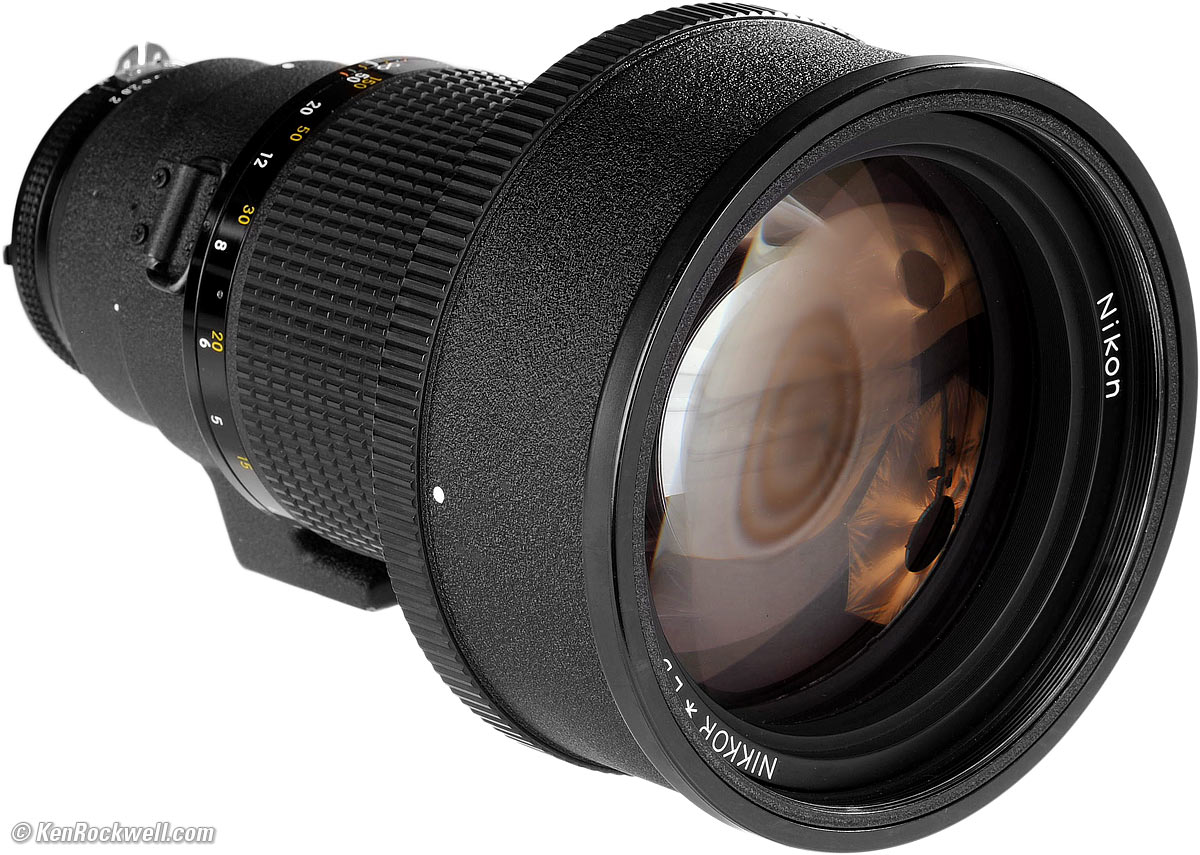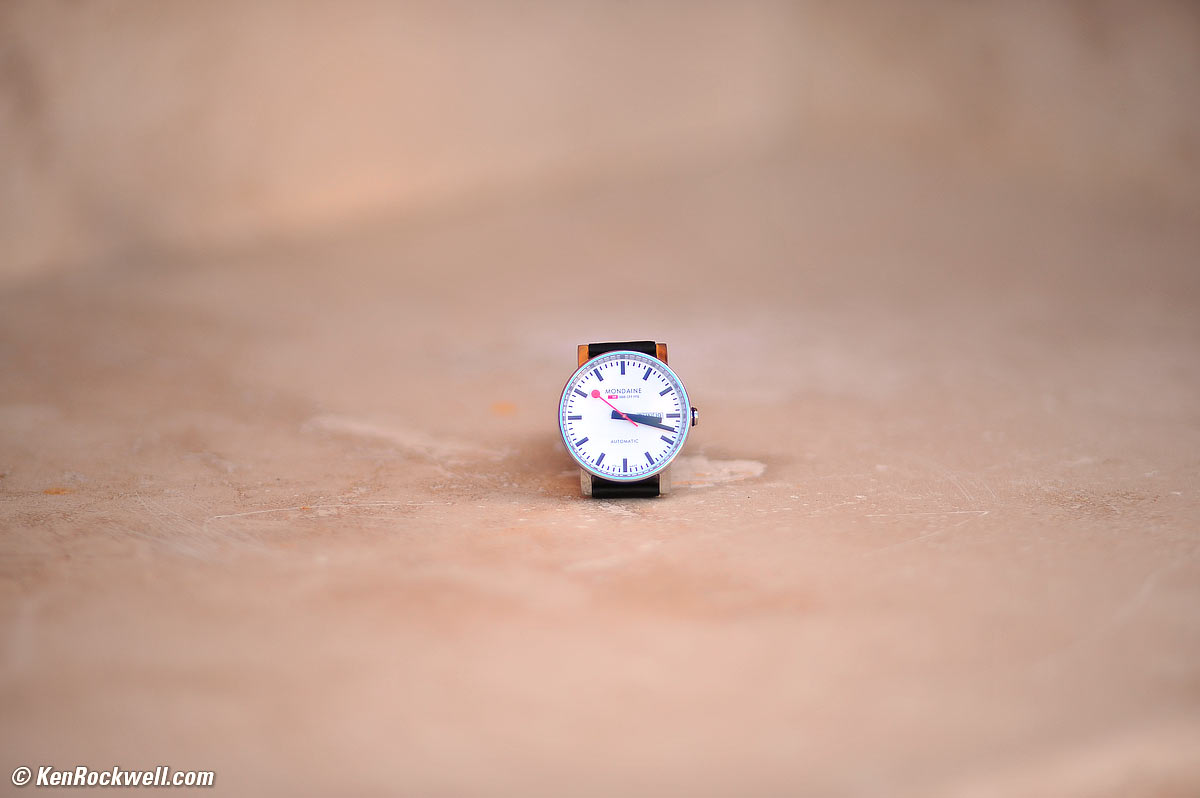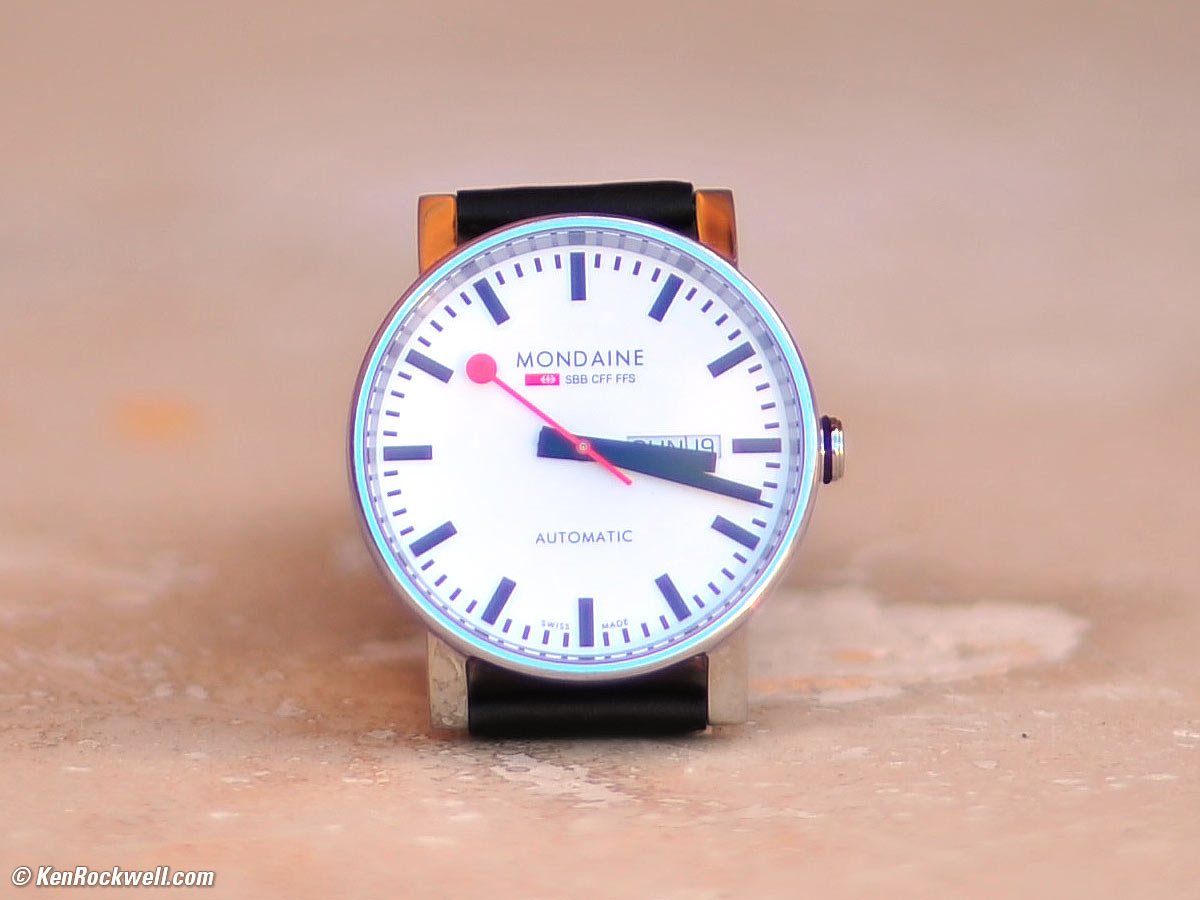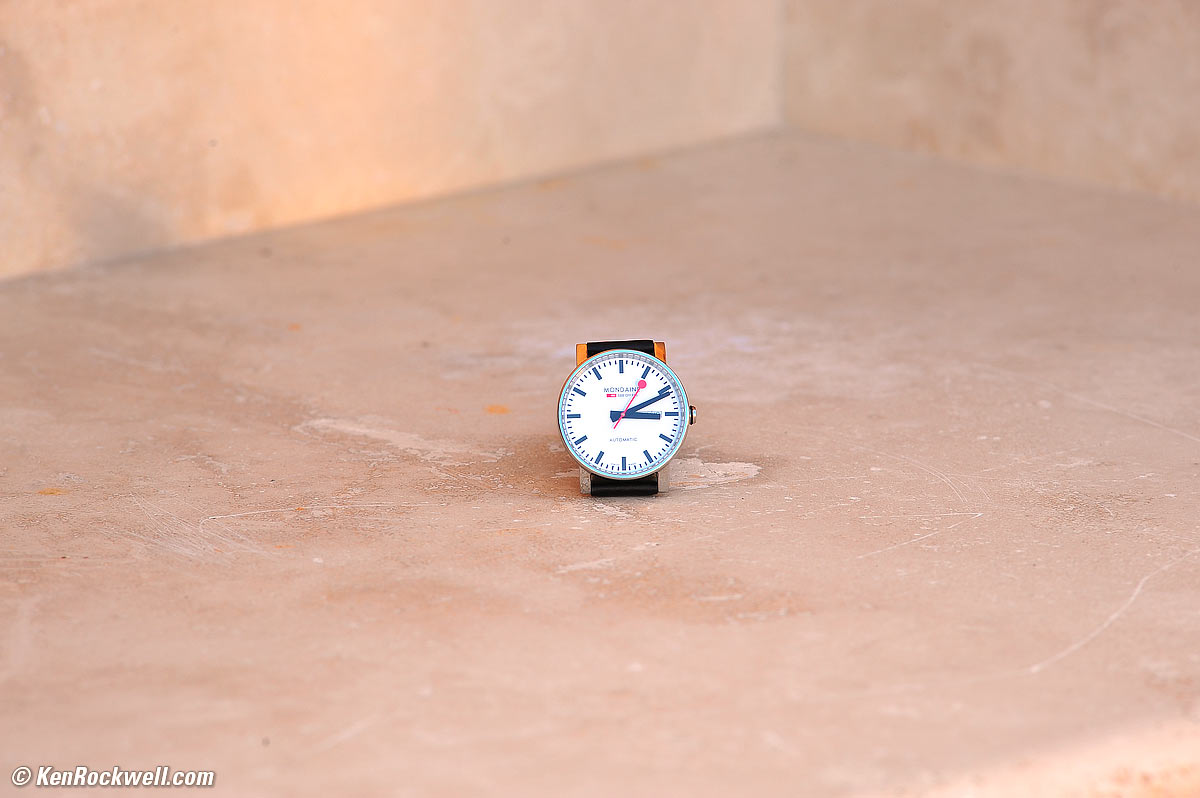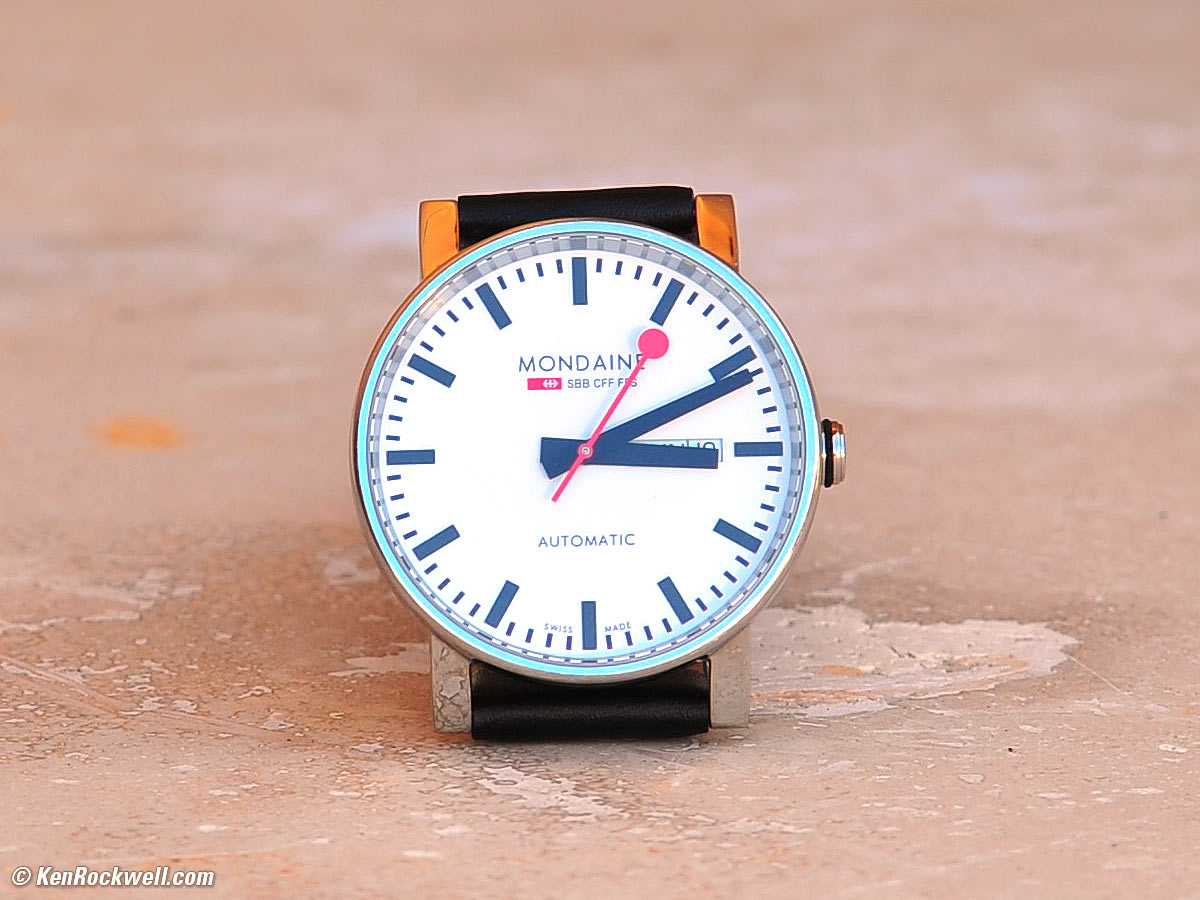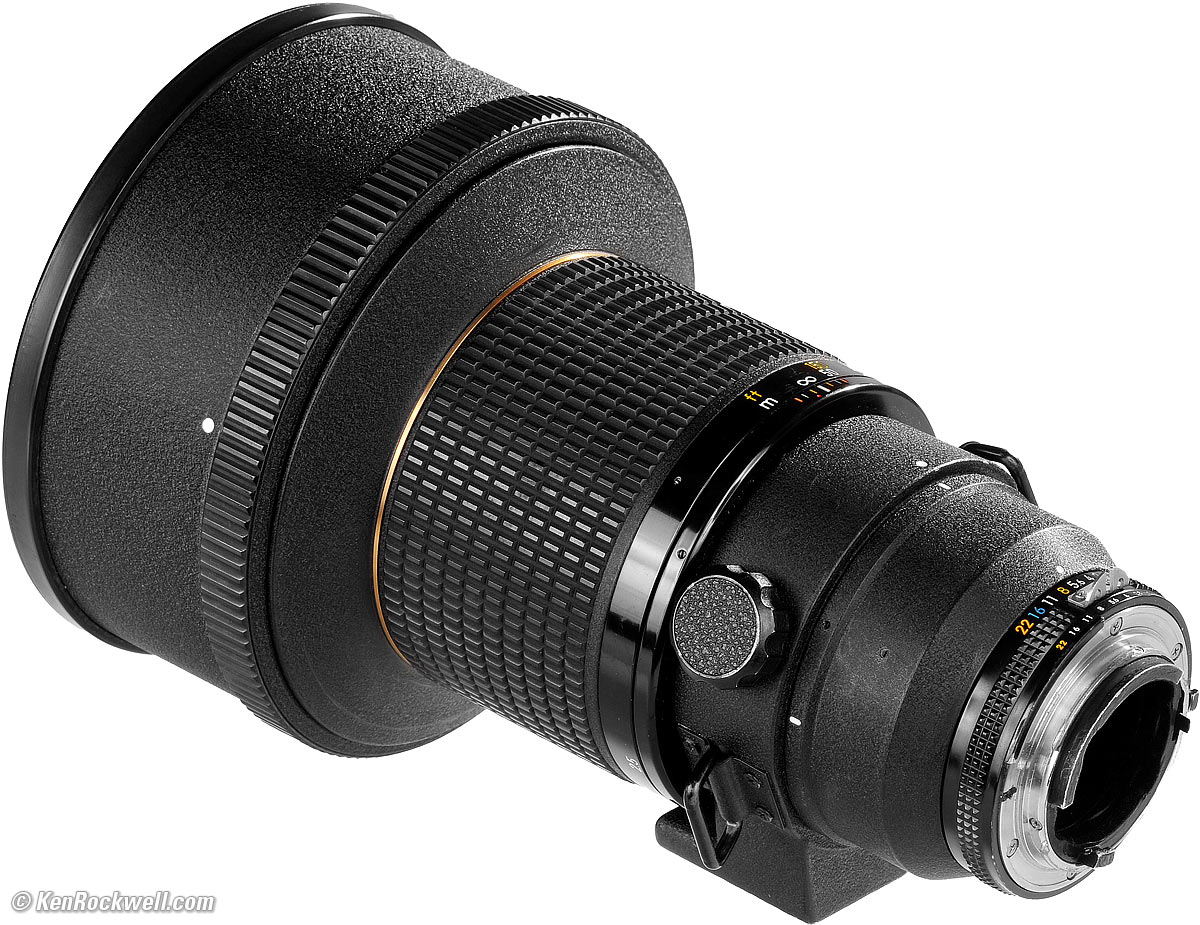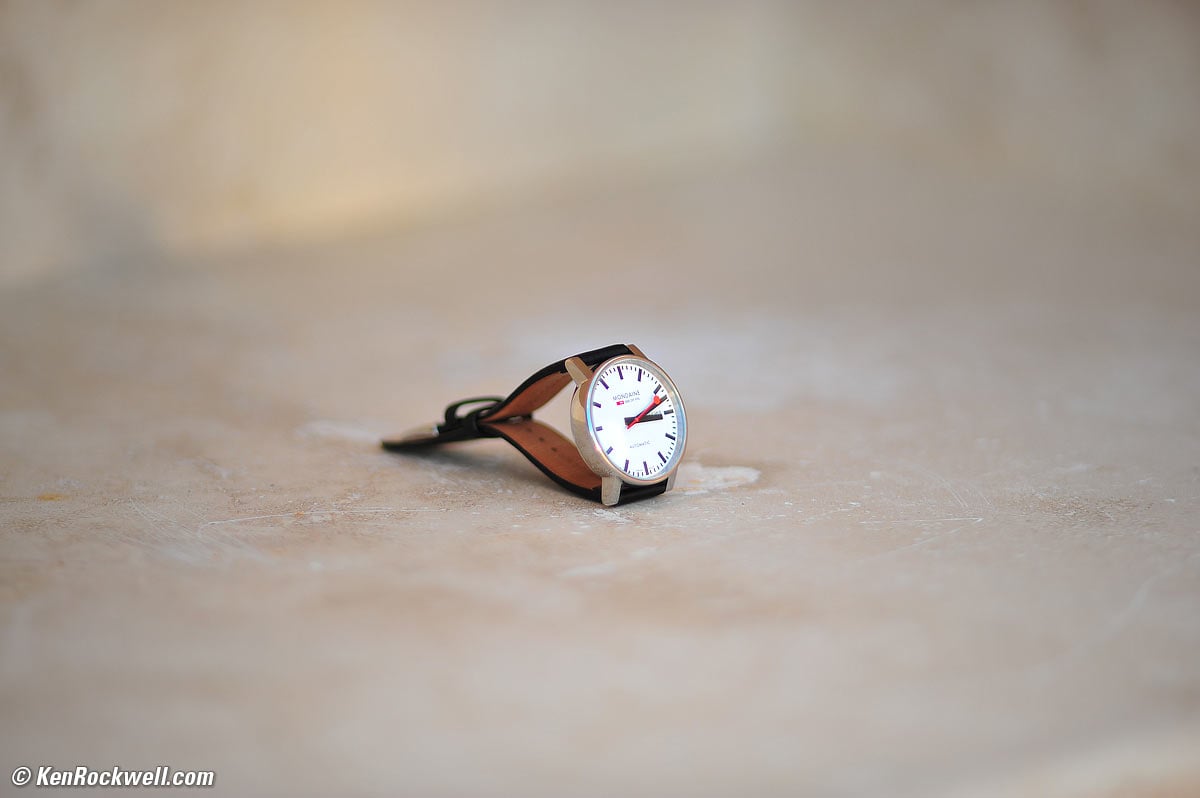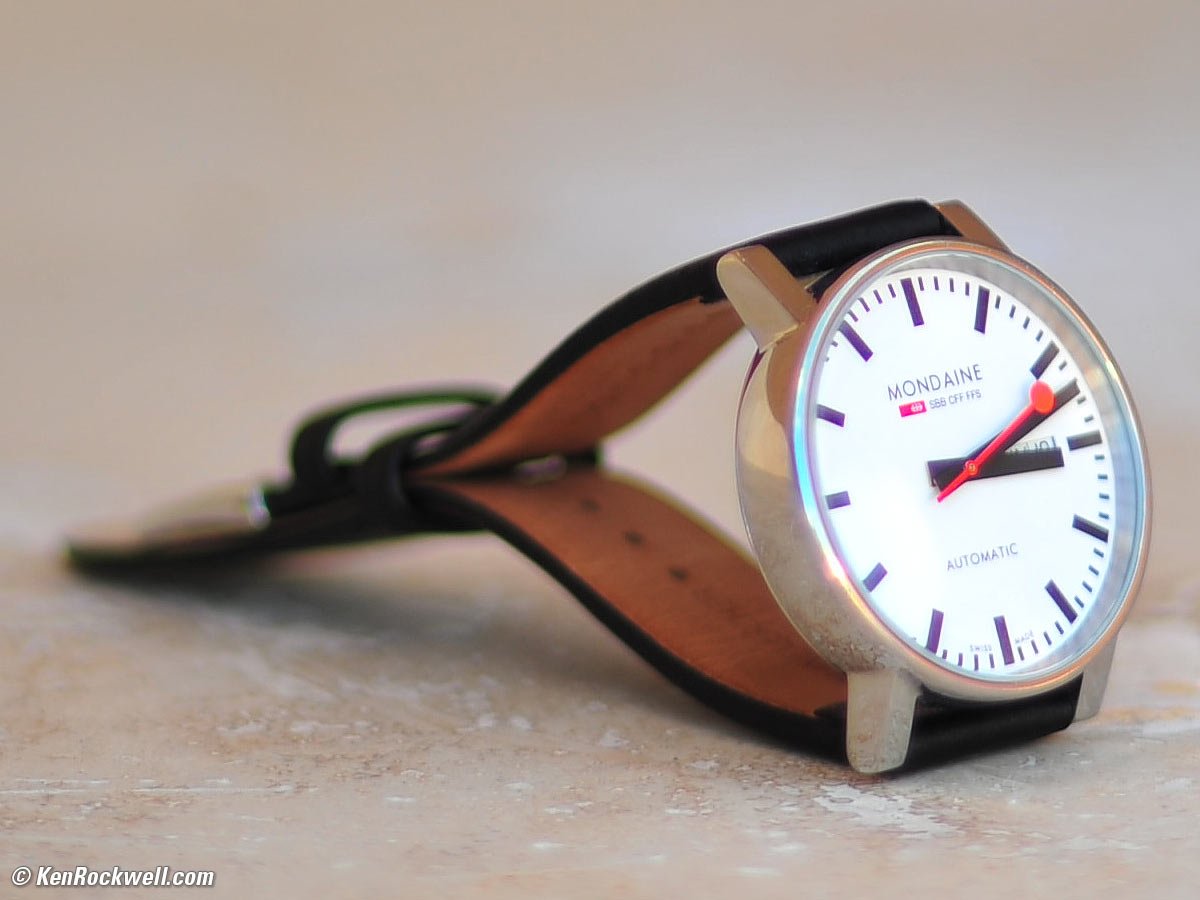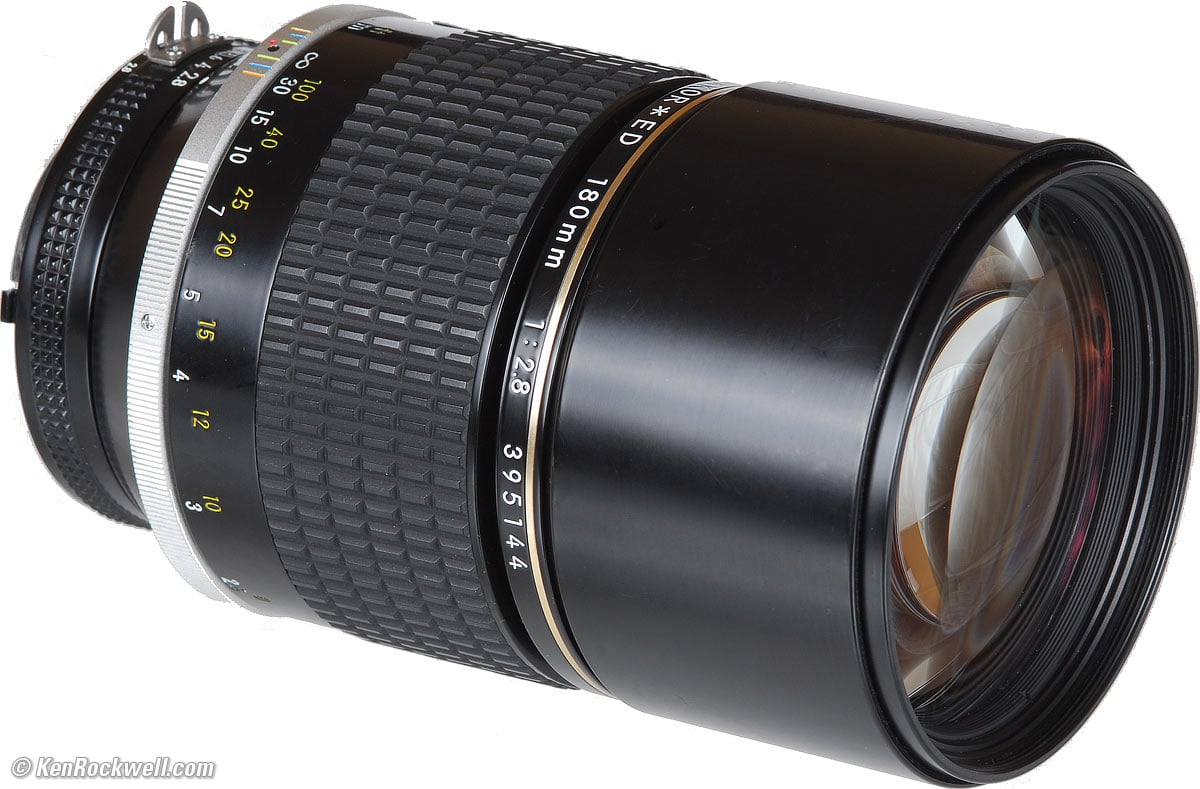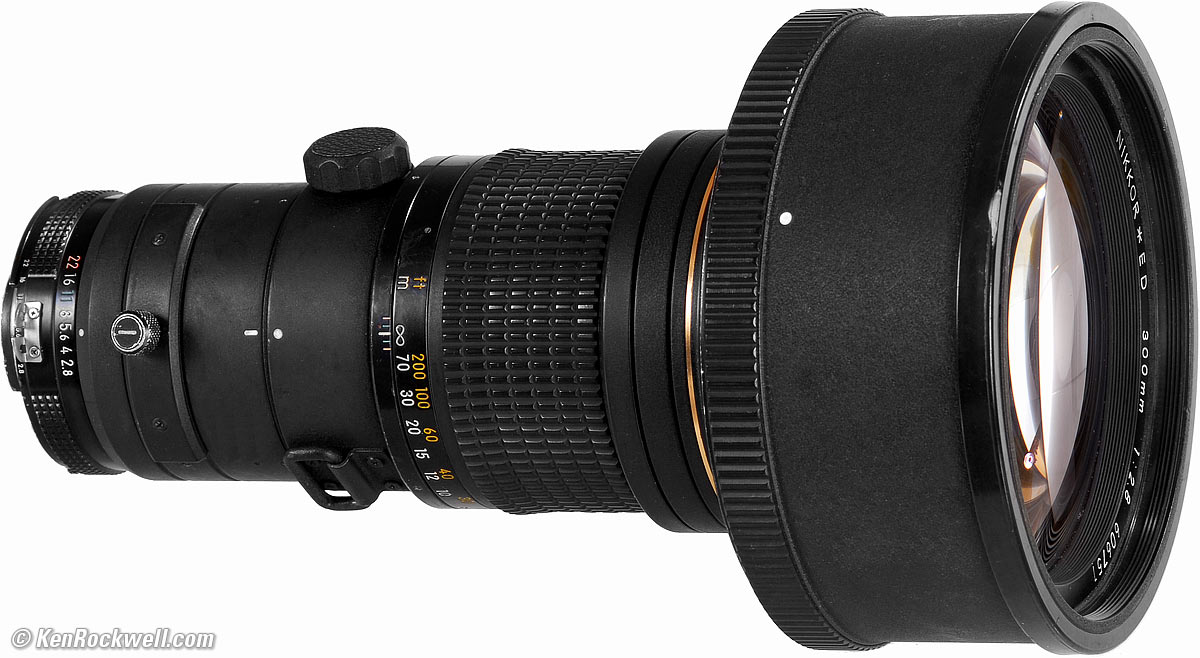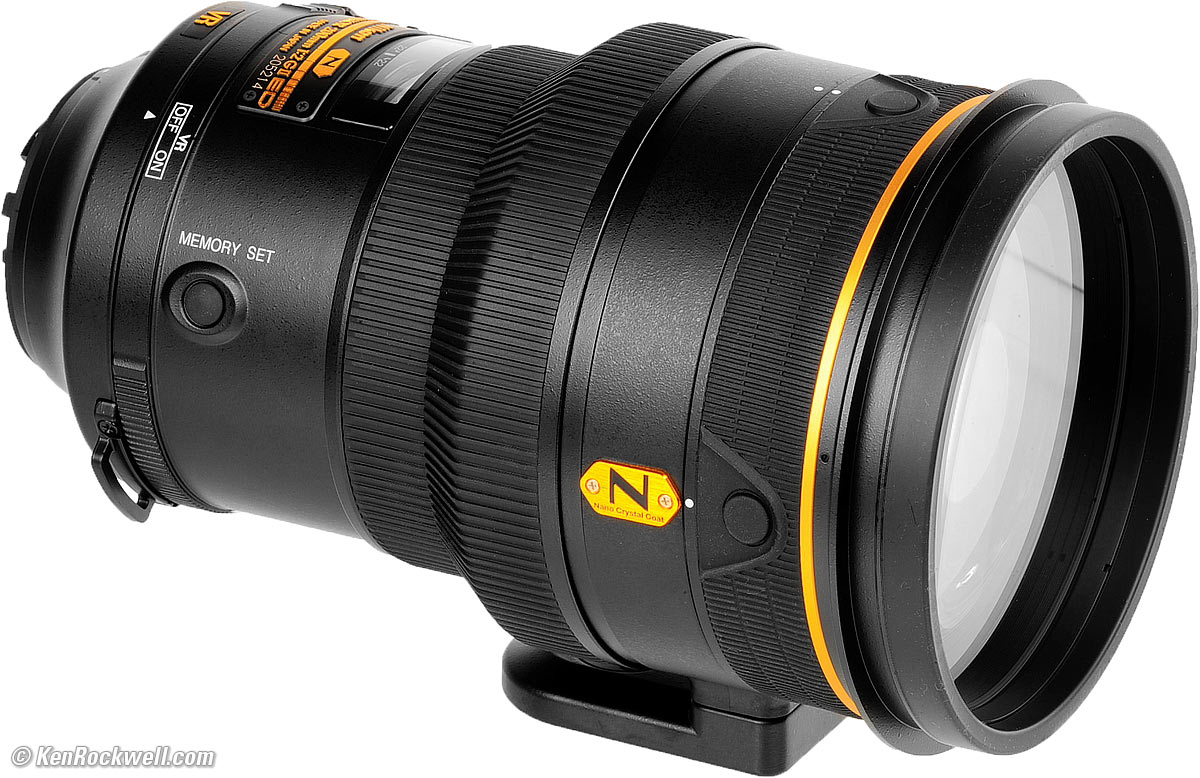Nikon 200mm f/2
ED-IF, AI & AI-s Bokeh King
(1977-2005)
Introduction Format Compatibility Specs
Performance Compared Recommendations
Nikon NIKKOR✱ED 200mm f/2 AI-s (FX, DX and 35mm coverage, metal 122mm filter thread, built-in hood, 84.7 oz./2,400g, 8.2'/2.5m close focus, usually about $1,500 ~ $2,100 used if you know How to Win at eBay). bigger.
My biggest source of support is when you use any of these links to approved sources, especially this link directly to them at eBay where I got mine, when you get anything, regardless of the country in which you live. Thanks for helping me help you! Ken.
May 2019 Better Pictures Nikon Reviews Nikon Lenses Nikon Manual-Focus Lenses All Reviews
Why Fixed Lenses Take Better Pictures
Introduction
Top Intro Format Compatibility Specs
Performance Compared Recommendations
|
I buy only from these approved sources. I can't vouch for ads below. |
This is the worlds's first ultra-speed 200mm lens. Today it still commands very high prices used because of its extraordinary bokeh. Its slight residual chromatic and spherical aberrations make it slightly less sharp than today's newest autofocus 200/2 VR in the lab, but these unique aberrations actually help make this lens have some of the best bokeh the world has ever seen.
wide-open that make it less sharp than the newest 200/2 VR models, this original manual-focus 200/2 has extraordinary bokeh.
As an ultra-exotic it sold for $3,000 in the 1980s and over $4,000 in the 1990s, or the equivalent of over $7,000 in 2019 dollars, all at discount at B&H Photo!
It was introduced as an AI (Automatic meter Indexing) lens in 1977 and updated to AI-s (Automatic meter Indexing with shutter-preferred optimized linear diaphragm actuation) as shown here in 1982. These models have a built-in locking telescoping hood:
Built-in Locking Hood Extended, Nikon NIKKOR✱ED 200mm f/2 AI-s. bigger.
The 200/2 was cosmetically updated, still with the same optics, in 1986. That model (not shown here) came in a fancy trunk case and uses a separate clamp-on HE-4 hood. It has a permanently attached front protective glass plate and uses rear gel, not 122mm front, filters.
An completely new Autofocus 200mm f/2 VR (Vibration Reduction) was introduced in 2004, and a cosmetic variant of this was introduced in 2010 as the 200mm f/2 VR II. These AF lenses are completely different and not covered here; see their reviews at Nikon 200mm f/2 VR and Nikon 200mm f/2 VR II.
I got my 200mm f/2 IF-ED at this link to them at eBay (see How to Win at eBay).
New
 World's First 200mm f/2.
World's First 200mm f/2.
 ED extra-low dispersion glass for greatly reduced secondary chromatic aberration. Without this glass a 200mm lens this fast would not be possible.
ED extra-low dispersion glass for greatly reduced secondary chromatic aberration. Without this glass a 200mm lens this fast would not be possible.
 Internal Focussing (IF) so nothing moves externally as focused.
Internal Focussing (IF) so nothing moves externally as focused.
Good
 Among the best bokeh of any lens, which is why these till sell for double what a manual focus 300/2.8 does.
Among the best bokeh of any lens, which is why these till sell for double what a manual focus 300/2.8 does.
 Ultra fast lens ideal for indoor and night sports, theater, concerts and ultra-defocussed portrait backgrounds.
Ultra fast lens ideal for indoor and night sports, theater, concerts and ultra-defocussed portrait backgrounds.
 Internal Focussing (IF) means it can be focused fast with just the flick of a fingertip, nothing but the focus ring moves externally as focused. This is ideal for shooting sport and action!
Internal Focussing (IF) means it can be focused fast with just the flick of a fingertip, nothing but the focus ring moves externally as focused. This is ideal for shooting sport and action!
 Smooth and precise manual focus ideal for use on a tracking focus rig for movies and video.
Smooth and precise manual focus ideal for use on a tracking focus rig for movies and video.
 Exquisite 9-blade diaphragm for round out-of-focus highlights and magnificent 18-pointed sunstars.
Exquisite 9-blade diaphragm for round out-of-focus highlights and magnificent 18-pointed sunstars.
 Built-in locking hood.
Built-in locking hood.
 Superlative mechanics: all metal, all engraved markings and no plastic.
Superlative mechanics: all metal, all engraved markings and no plastic.
 Heirloom-quality design and build to last beyond a lifetime.
Heirloom-quality design and build to last beyond a lifetime.
 Tubular velvet-lined Corinthian leather case and strap included.
Tubular velvet-lined Corinthian leather case and strap included.
 Made domestically in Japan.
Made domestically in Japan.
Bad
 The same spherical and chromatic aberrations that create the incredible bokeh make this lens not quite as sharp when shot wide-open for scientific use like astronomy.
The same spherical and chromatic aberrations that create the incredible bokeh make this lens not quite as sharp when shot wide-open for scientific use like astronomy.
Missing
 No focus preset ring; this lens has a shorter barrel than the similar 300/2.8 and I guess Nikon just ran out of room.
No focus preset ring; this lens has a shorter barrel than the similar 300/2.8 and I guess Nikon just ran out of room.
 No drop-in filter holder, uses regular 122mm front screw-in filters. Again, the shorter barrel lost room for this.
No drop-in filter holder, uses regular 122mm front screw-in filters. Again, the shorter barrel lost room for this.
 Nothing else missing at the time; autofocus and Vibration Reduction hadn't been invented yet.
Nothing else missing at the time; autofocus and Vibration Reduction hadn't been invented yet.
 No plastic.
No plastic.
 No printing; every marking is deeply engraved and filled with paint to last a few lifetimes.
No printing; every marking is deeply engraved and filled with paint to last a few lifetimes.
 Not off shored to some second- or third-world country for cheap labor as Nikon usually does today; this is a precision-made masterpiece.
Not off shored to some second- or third-world country for cheap labor as Nikon usually does today; this is a precision-made masterpiece.
Format
Top Intro Format Compatibility Specs
Performance Compared Recommendations
I got my 200mm f/2 IF-ED at this link to them at eBay (see How to Win at eBay).
This is a full frame FX lens, and I'm reviewing it as such.
It works great on DX cameras, too, on which you may make the usual inferences.
Compatibility
Top Intro Format Compatibility Specs
Performance Compared Recommendations
I got my 200mm f/2 IF-ED at this link to them at eBay (see How to Win at eBay).
This manual-focus lens works great with most full-frame Nikon cameras made since 1977, both FX digital and 35mm. Of course it won't autofocus on any camera, but usually offers color matrix metering and aperture-preferred auto exposure if you like. It offers Aperture-priority, shutter-priority and full program auto exposure on the Nikon FA, and Matrix Metering on all FX cameras as well as the Nikon F4, Nikon FA and Nikon F6.
It also works great on better DX cameras, but won't meter with the cheapest DX cameras or cheaper autofocus 35mm cameras.
It works on the Z-series mirrorless cameras with the FTZ Adapter.
On all FX digital, Z-series mirrorless cameras, better DX cameras and the F6 be sure to set "200mm" and "f/2" at MENU > SETUP > NON-CPU LENS DATA.
See Nikon Lens Compatibility for details on your camera. Read down the "AI, AI-s"column.
Specifications
Top Intro Format Compatibility Specs
Performance Compared Recommendations
I got my 200mm f/2 IF-ED at this link to them at eBay (see How to Win at eBay).
Name
Nikon calls this the Nikon NIKKOR✱ED 200mm f/2 AI-s (or AI).
NIKKOR: Nikon's brand name for all their lenses.
ED: Magic Extra-low Dispersion glass for reduced secondary chromatic aberration.
AI-s: Automatic (exposure meter) Indexing, with shutter-preferred optimized linear diaphragm actuation, or
AI: Automatic (exposure meter) Indexing.
Optics
Nikon NIKKOR✱ED 200mm f/2 AI-s Internal Optical Construction. ED Glass and Glass elements. bigger.
10 elements in 8 groups.
Two huge ED extra-low dispersion elements, which help reduce secondary axial chromatic aberration.
Nikon Super Integrated multicoating (SIC).
Covered in depth in US Patent 4,176,913.
Coverage
Diaphragm
Nikon NIKKOR✱ED 200mm f/2 AI-s at f/5.6. bigger.
9 straight blades.
Stops down to f/22 with full-stop clicks.
You may select any aperture anywhere between clicks.
Focal Length
200mm.
When used on DX cameras, it sees the same angle of view as a 300 mm lens sees when used on an FX or 35mm camera.
See also Crop Factor.
Angle of View
12º 20' diagonal on FX.
8º diagonal on DX.
Focus Scale
Yes, correctly color-coded in white for meters and in yellow for feet.
Infinity Focus Stop
No, focuses a little past infinity to allow for the effect of temperature on the special ED low-dispersion glass.
Depth of Field Scale
Nikon NIKKOR✱ED 200mm f/2 AI-s. bigger.
Yes, color-coded to the aperture values.
Reproduction Ratio Scale
No.
Infrared Focus Index
Yes.
Close Focus
8.2 feet (2.5 meters).
Maximum Reproduction Ratio
1:9.5 (0.105×).
Front Cap
A black fake leather sock, lined with red Hungarian velvet.
Filters
Solid aluminum alloy 122mm front filter thread.
No drop-in filter holder.
Hood
Built-in Locking Hood Extended, Nikon NIKKOR✱ED 200mm f/2 AI-s. bigger.
Built-in telescoping fuzzy black-flocked metal tubular hood.
It locks if extended and you screw it backwards into the lens body, it doesn't lock when retracted.
It doesn't lock that hard, so if it slips you might want to try putting a fat rubber band behind it on the barrel.
Tripod Collar
The tripod collar is permanently attached, with one friction lock thumb screw.
It has no detents, but does have two strap lugs.
It has a single ¼″ × 20 TPI thread.
Case
CL-63 Corinthian Leather tubular case, lined with Hungarian red velvet, and strap, included. By now all these cases are so old that most have decayed and fallen apart.
The newest AI-s version came with a hard trunk roadie-style case.
Size
5.43" ø maximum diameter × 8.43" extension from flange (8.74" overall).
138 mm ø maximum diameter × 214 mm extension from flange (222 mm overall).
Weight
84.7 oz. (5.3 pounds or 2,400 g).
Quality
Made in Japan.
Serial Number Ranges
AI version not seen here (has same optics): 176,000 (1977) to 177,500 (1982). Nikon made about 1,250 of these.
AI-s version seen here: 178,500 (1982) to 179,250 (1986). Nikon make only about 700 of these.
Newer AI-s version with same optics not seen here: 200,000 (1986) to 202,000 (2005). Nikon made about 1,800 of these.
Price, USA
May 2019
If you know How to Win at eBay, typically about $1,500 ~ $2,100 used. Prices actually paid range from up to $3,000 for an unused one in the trunk case to $1,200 for a worn old beater that still works well.
December, 1998
$4,199.00 new (gray-market) or $4,625 (USA) at B&H Photo (that's $6,550 or $7,215 in 2019 dollars).
December, 1997
$4,199.00 new (gray-market) or $4,625 (USA) at B&H Photo (that's $6,650 or $7,325 in 2019 dollars).
December, 1996
$4,199.00 new at B&H Photo (that's $6,800 in 2019 dollars).
December, 1995
$4,199.00 new at B&H Photo (that's $7,000 in 2019 dollars).
December, 1994
$3,799.00 new at B&H Photo (that's $6,515 in 2019 dollars).
December, 1992
$3,048.95 new at B&H Photo (that's $5,525 in 2019 dollars).
December, 1991
$2,899.00 new w/CL-63 at B&H Photo (that's $5,410 in 2019 dollars).
December, 1988
$3,069.00 new w/CL-63 at B&H Photo (that's $6,600 in 2019 dollars).
January, 1987
$2,599.00 new w/CL-63 at B&H Photo (that's $5,185 in 2019 dollars).
June, 1986
$2,099.00 new w/CL-63 case at B&H Photo (that's $4,870 in 2019 dollars).
Performance
Top Intro Format Compatibility Specs
Performance Compared Recommendations
Color Rendition Distortion Ergonomics
Falloff Filters Lateral Color Fringes
I got my 200mm f/2 IF-ED at this link to them at eBay (see How to Win at eBay).
Overall
The 200/2 ED was a huge milestone in the 1970s, however optically today it's not that exciting unless you really, really need f/2 rather than f/2.8 at 200mm. The 180mm f/2.8 ED and today's f/2.8 zooms like the state-of-the-art 70-200mm f/2.8E FL are all sharper at f/2.8 and smaller; they just don't go to f/2.
This 200/2 is a fantastic portrait lens, but less well suited to astronomy and landscape due to its finite performance at f/2.
Focus
Manual focus is flawless.
The focus ring moves with a single fingertip.
Focus Breathing
Focus breathing is the image changing size as focused in and out. It's important to cinematographers that the image not breathe because it looks funny if the image changes size as focus gets pulled back and forth between actors. If the lens does this, the image "breathes" by growing and contracting slightly as the dialog goes back and forth.
The image from this 200/2 gets larger as focused more closely.
Bokeh
Bokeh, the feel or quality of out-of-focus areas as opposed to how far out of focus they are, is exquisite Backgrounds completely vanish at f/2, and at smaller apertures, too.
Here are photos from headshot distance wide-open. Click any for the camera-original © JPG file:
Click any for the camera-original © JPG file. (you'll see sensor dirt at the smaller apertures.)
As always, if you want to throw the background as far out of focus as possible, shoot at f/2 and get as close as possible.
Color Rendition
Color rendition is neutral, matching my other multicoated NIKKOR lenses from the 1970s through today.
Distortion
The Nikon 200mm f/2 ED has no visible or measurable distortion.
Ergonomics
Most of the lens is the big fat front optical section:
Huge Front ED element, Nikon NIKKOR✱ED 200mm f/2 AI-s. bigger.
The barrel has a big focus ring, covered in Nikon's signature flat-topped pyramidal "iron block" rubbery grip material. Unlike the crappy imitation rubber Nikon has used since around year 2000 on autofocus lenses that gets sticky after about 12 years, this rubber stays just like new forever.
The solid cast-alloy aperture ring is easy to set with a single fingertip. It's easy to set to any intermediate aperture, and has full-stop clicks. Pros set their apertures by feel, counting clicks up or down from f/2 or f/22.
Falloff
Falloff on FX and 35mm is minor at f/2, and goes away by f/4. This lens is intended to be shot at f/2 all the time; no one pays thousands of dollars for this beast to shoot it at f/2.8 or smaller where you could use your normal f/2.8 zoom to do the same thing.
It won't be an issue at all on DX (see crop factor).
I've greatly exaggerated the falloff by shooting a gray field and placing these on a gray background; it will not look this bad in actual photos of real things:
200mm f/2 IF-ED falloff on FX and 35mm at infinity.
© 2019 KenRockwell.com. All rights reserved. |
Filters, use with
122mm filters screw in the front.
There's no need for thin filters. You can stack several 122mm filters without vignetting on full-frame.
Go ahead and use your standard rotating polarizer and grad filters, if you have them this size.
Lateral Color Fringes
There are no lateral color fringes as shot on Nikon cameras, which by default correct for any that may be there.
There are plenty of other minor color fringes visible today when shot on high resolution digital cameras if you look closely at 100% on your computers. The greatest among these is lots of spherochromatism, which will cause color fringes on of things that aren't in perfect focus. Spherochromatism is a completely different aberration in a different dimension than lateral color fringes.
Macro Performance
It doesn't get very close; use the state-of-the-art 200mm f/4 IF-ED AF-D if you want a real macro lens.
Here's how close it gets on full-frame:
Wide-open at f/2
Mondaine A132.30348.11SBB at close-focus distance, 19 May 2019. Nikon D3. bigger or camera-original © file.
1,200 × 900 pixel crop from above. bigger or camera-original © file.
If this crop is about 3" (7.5cm) wide on your screen, the complete images would print at a big 7 × 11″ (18 × 27 cm) at this same high magnification.
If this crop is about 6" (15cm) wide on your screen, the complete images would print at a jumbo 14 × 21″ (35 × 54 cm) at this same high magnification.
If this crop is about 12" (30cm) wide on your screen, the complete images would print at a huge 28⅓ × 42½″ (70 × 108 cm) at this same extremely high magnification!
No, it's not that sharp in the lab at f/2 at macro distances, but so what, only a nut uses a lens like this this close at f/2, and if he does, he probably wants thus effect.
At f/8
It sharpens up at smaller apertures like f/2.8; here it is at f/8:
Mondaine A132.30348.11SBB at close-focus distance, 19 May 2019. Nikon D3. bigger or camera-original © file.
1,200 × 900 pixel crop from above. bigger or camera-original © file.
If this crop is about 3" (7.5cm) wide on your screen, the complete images would print at a big 7 × 11″ (18 × 27 cm) at this same high magnification.
If this crop is about 6" (15cm) wide on your screen, the complete images would print at a jumbo 14 × 21″ (35 × 54 cm) at this same high magnification.
If this crop is about 12" (30cm) wide on your screen, the complete images would print at a huge 28⅓ × 42½″ (70 × 108 cm) at this same extremely high magnification!
Mechanical Quality
Nikon NIKKOR✱ED 200mm f/2 AI-s. bigger.
This is one of Nikon's best-made lenses of all time. It is made to even better standards than LEICA's lenses because Nikon uses even longer-life lubricants good for about 50 years, rather than the 15- to 20- years over which LEICA's lubricants work.
Finish
Crinkle-coated matte black enamel over black-anodized aluminum
Front Bumper
Rubber, on front of hood.
Hood
Solid alloy.
Flocked interior.
Screw-locking.
Filter Threads
Solid alloy.
Gold ED Band
Solid 14 karat gold.
That's the gold ring just in front of the focus ring.
Barrels
Metal.
Focus Ring
Rubber-covered solid alloy.
Rear Barrel
Metal.
Identity
Engraved into the very living metal and filled with paint around the front element, inside the filter threads.
Internals
All metal!
Dust Gasket at Mount
No.
Mount
Dull chromed metal.
Markings
All engraved and filled with paint.
Serial Number
Engraved and filled with paint around the front element, inside the filter threads.
Date Code
None found, use your algebra and your serial number.
Noises When Shaken
Clunking from the internal focus groups.
Some clinking from the strap lugs if you let them flop around.
Made in
Japan.
Sharpness
Lens sharpness has nothing to do with picture sharpness; every lens made in the past 100 years is more than sharp enough to make super-sharp pictures if you know what you're doing. The only limitation to picture sharpness is your skill as a photographer. It's the least talented who spend the most time worrying about lens sharpness and blame crummy pictures on their equipment rather than themselves. Skilled photographers make great images with whatever camera is in their hands; I've made some of my best images of all time with an irreparably broken camera! Most pixels are thrown away before you see them, but camera makers don't want you to know that.
If you're not getting ultra-sharp pictures with this, be sure not to shoot at f/16 or smaller where all lenses are softer due to diffraction, always shoot at ISO 100 or less because cameras become softer at ISO 200 and above, avoid shooting across long distances over land which can lead to atmospheric heat shimmer, be sure everything is in perfect focus, set your camera's sharpening as you want it (I set mine to the maximum) and be sure nothing is moving, either camera or subject. If you want to ensure a soft image with any lens, shoot at f/22 at ISO 1,600 at default sharpening in daylight through heat shimmer of rapidly moving subjects at differing distances in the same image.
These cautions aside, this lens isn't that ultrasharp at f/2. It was pushing the performance envelope in its day, and you'll see various spherical and chromatic aberrations at f/2 which limit performance if you're looking at files shot at f/2 at 100% on your computer.
Look at the images at a reasonable size and it's sharp at f/2, just not quite as contrasty as when stopped down. Also realize that there is zero depth of field at f/2, so only a vapor-thin plane of nothing is actually in perfect focus.
It gets much sharper as stopped down.
Be sure you're in perfect focus, as even the slightest lack of perfect focus may lead to you seeing green or magenta color fringes caused by spherochromatism. If you see these, try refocusing with magnified live view, or stop down a little and spherochromatism goes away.
Spherochromatism
Spherochromatism, also called "color bokeh" by laymen, is an advanced form of chromatic aberration in a different dimension than lateral color. It can cause colored fringes on out-of-focus highlights, usually seen as green fringes on backgrounds and magenta fringes on foregrounds. Spherochromatism is common in fast lenses of moderate focal length when shooting contrasty items at full aperture. It goes away as stopped down.
The NIKKOR 200mm f/2 IF-ED has plenty of spherochromatism at f/2. It's what made this lens impossible to design without ED glass, and now with ED glass there is still plenty of spherochromatism if you look for it.
Background highlights tend to have green fringes, and foreground highlights tend to have magenta fringes:
Mondaine A132.30348.11SBB at close-focus distance, 19 May 2019. Nikon D3. bigger or camera-original © file.
1,200 × 900 pixel crop from above. bigger or camera-original © file.
If this crop is about 3" (7.5cm) wide on your screen, the complete images would print at a big 7 × 11″ (18 × 27 cm) at this same high magnification.
If this crop is about 6" (15cm) wide on your screen, the complete images would print at a jumbo 14 × 21″ (35 × 54 cm) at this same high magnification.
If this crop is about 12" (30cm) wide on your screen, the complete images would print at a huge 28⅓ × 42½″ (70 × 108 cm) at this same extremely high magnification!
Sunstars
The 200/2 IF-ED's magnificent 9-bladed diaphragm makes exquisite 18-pointed sunstars on brilliant points of light at almost all apertures.
Teleconverters
The 200mm f/2 ED-IF works with the TC-1, TC-200, TC-201, TC-14 and TC-14B, and maybe even the TC-16A autofocusing teleconverter. Nikon warns that at f/11 and smaller there can be uneven exposure at high shutter speeds.
The TC-2, TC-300 and TC-301 converters won't fit because they need to poke too far into the back of a lens.
The current TC-E series won't mount; their mounts are machined to prevent this.
The smaller TC-14A is designed for slower, shorter lenses and probably will vignette a bit, but otherwise work and work pretty well on DX.
The TC-14B turns this into a 280mm f/2.8 and it works OK if you already own a 200/2, but a 300/2.8 works much better than this converted combo. Shot wide-open the 200/2 and TC-14B combo have a lot of red flare.
Forget teleconverters unless you already own this lens; the 300/2.8 manual focus costs only half as much as this 200/2.
Compared
Top Intro Format Compatibility Specs
Performance Compared Recommendations
I got my 200mm f/2 IF-ED at this link to them at eBay (see How to Win at eBay).
Versus the 180mm f/2.8 ED
Nikon NIKKOR✱ED 180mm f/2.8 AI-s.
Here's the reason you won't see a lot of these multi-thousand-dollar 200mm f/2 AI-s lenses in use: the 180mm f/2.8 ED AI-s is already much sharper when both lenses are shot at f/2.8, and stays sharper at larger apertures.
Unless you really are going to shoot the 200/2 at f/2, the 180mm f/2.8 ED AI-s or most of the recent f/2.8 zooms, especially the 70-200/2.8E FL, are sharper than this 200/2 when shot at the same aperture.
While scientists and astronomers won't love that this 200mm f/2 IF-ED is softer wide-open at f/2, portraitists love it for its natural skin-softening effect along with its inimitable bokeh and soft backgrounds. This 200/2 is all about speed and bokeh, not sharpness wide-open.
Versus the 300mm f/2.8
Nikon NIKKOR✱ED 300mm f/2.8 AI-s.
The 300mm f/2.8 IF-ED AI-s is a very similar lens in design, size and weight, but it's sharper wide-open. This 300mm design is super sharp wide-open at f/2.8, while the 200/2 suffers from more spherical and chromatic aberrations wide-open.
A 300mm lens at f/2.8 will throw the background more out of focus than a 200mm f/2; defocus has more to do with focal length than f/number.
Bokeh quality is better with the 200/2 than the 300/2.8. The 300/2.8 is more neutral while the 200/2's bokeh is softer due to the additional aberrations wide-open.
Nikon made just under 4,000 of the manual-focus 200mm f/2s versus over 16,000 of the 300/2.8 manual focus lenses, and thus the 300/2.8 sells for about half of what this 200/2 does. If you have to ask, get the 300mm f/2.8!
Versus the AF 200/2 VR
The Nikon 200mm f/2 VR and Nikon 200mm f/2 VR II share the same completely new optics. These optics are much sharper and contrasty wide-open at f/2, and add closer focusing and VR, but much more weight and expense.
The choice is simple: if you need VR or the sharpest possible optics for scientific use, get these new AF lenses, but if you need incredible bokeh, the original manual-focus 200/2 wins — and weighs and costs less.
Recommendations
Top Intro Format Compatibility Specs
Performance Compared Recommendations
This lens' bokeh is legendary, another reason it sells for twice the price of a 300/2.8 manual focus lens. Even at smaller apertures this lens' bokeh is extraordinary. The spherical and chromatic aberrations that make it a little less sharp in the lab are the same ones that create such extraordinary bokeh, and newer 200/2 lenses have removed these aberrations.
If all you need is f/2.8 or ultimate bokeh isn't your quest, any of the 180mm f/2.8 lenses or f/2.8 telephoto zooms will be sharper — but they don't open up to f/2 and can 't completely lose the background as this lens can.
This 200mm f/2 excels where you absolutely, positively need f/2, for instance, for headshots, fashion, portraiture and soft backgrounds or for shooting film in dim light. It's also great for cinema and movies where you really need to lose the background.
This is the Big Stick that lets you speak softly. When people see you coming with this, they know you're a seasoned full-time professional photographer who is both deserving of respect and who will create the fantastic photos for which they hired you. The world is loaded with eager young people with big DSLRs and 70-200 or 100-400 lenses who'll shoot anything for a buck. When you show up with this, people know you're head and shoulders above the rest. If you have the right people skills with this lens you can sweet talk yourself into free upgrades in seating or get special roof and other kinds of access, since you're obviously there because someone important hired you.
I use a clear (UV) filter to protect my exotic lens.
I'd use a 122mm B+W single-coated 010 UV filter or the 122mm B+W multicoated 010 UV filter to protect this lens.
I don't know that I'd pay extra for the multicoating just for today, but considering that filters last forever and transfer from lens to lens over the years, I would.
I got my 200mm f/2 IF-ED at this link to them at eBay (see How to Win at eBay).
If you've found the time and expense I incur to research and bring this all to you for free, my biggest source of support is when you use any of these links, especially this link directly to them at eBay (see How to Win at eBay), when you get anything, regardless of the country in which you live. Thanks! Ken.
Thanks for helping me help you!
Ken, Mrs. Rockwell, Ryan and Katie.
© Ken Rockwell. All rights reserved. Tous droits réservés. Alle Rechte vorbehalten.
Help Me Help You
I support my growing family through this website, as crazy as it might seem.
The biggest help is when you use any of these links when you get anything. It costs you nothing, and is this site's, and thus my family's, biggest source of support. These places always have the best prices and service, which is why I've used them since before this website existed. I recommend them all personally.
If you find this page as helpful as a book you might have had to buy or a workshop you may have had to take, feel free to help me continue helping everyone.
If you've gotten your gear through one of my links or helped otherwise, you're family. It's great people like you who allow me to keep adding to this site full-time. Thanks!
If you haven't helped yet, please do, and consider helping me with a gift of $5.00.
As this page is copyrighted and formally registered, it is unlawful to make copies, especially in the form of printouts for personal use. If you wish to make a printout for personal use, you are granted one-time permission only if you PayPal me $5.00 per printout or part thereof. Thank you!
Thanks for reading!
Mr. & Mrs. Ken Rockwell, Ryan and Katie.
